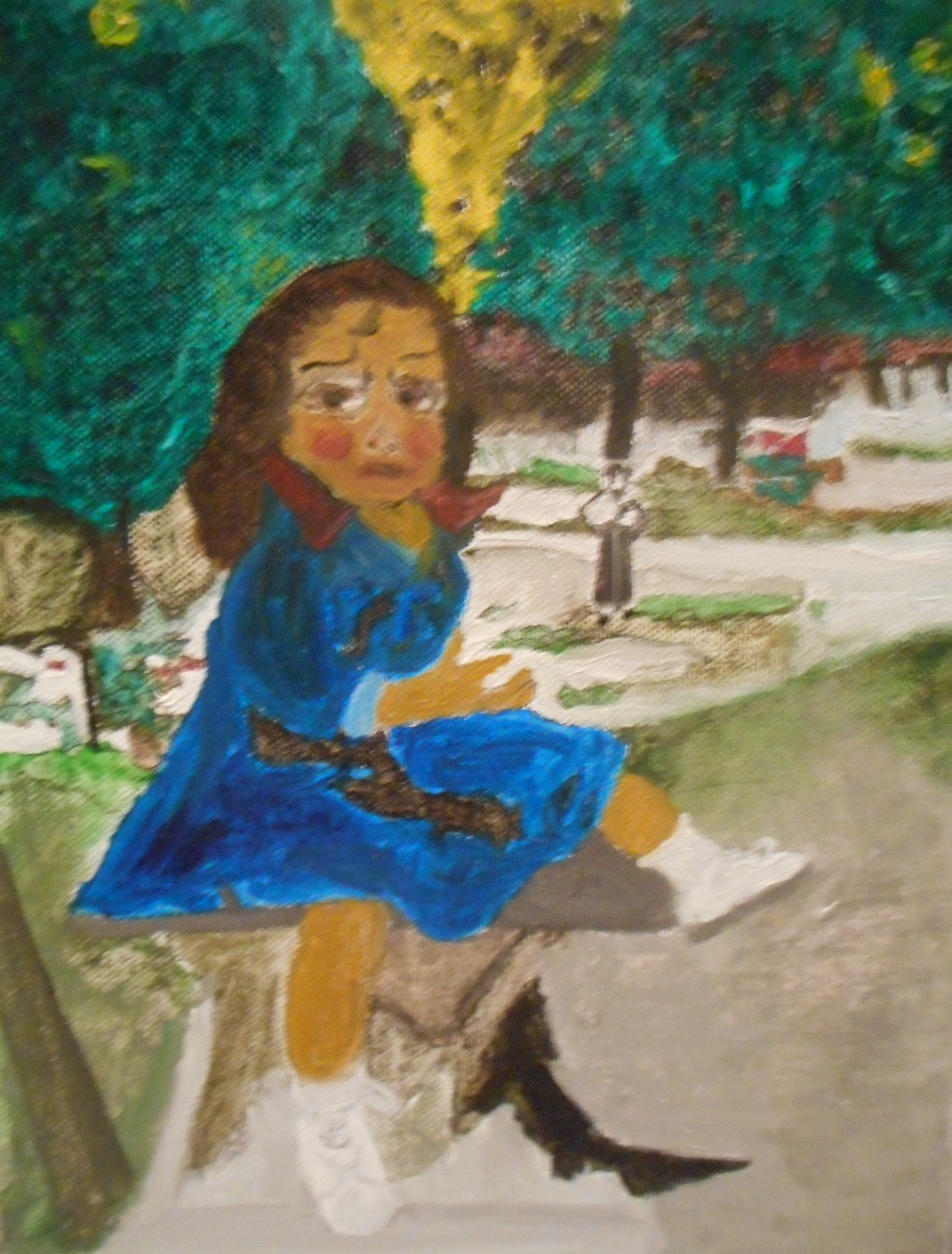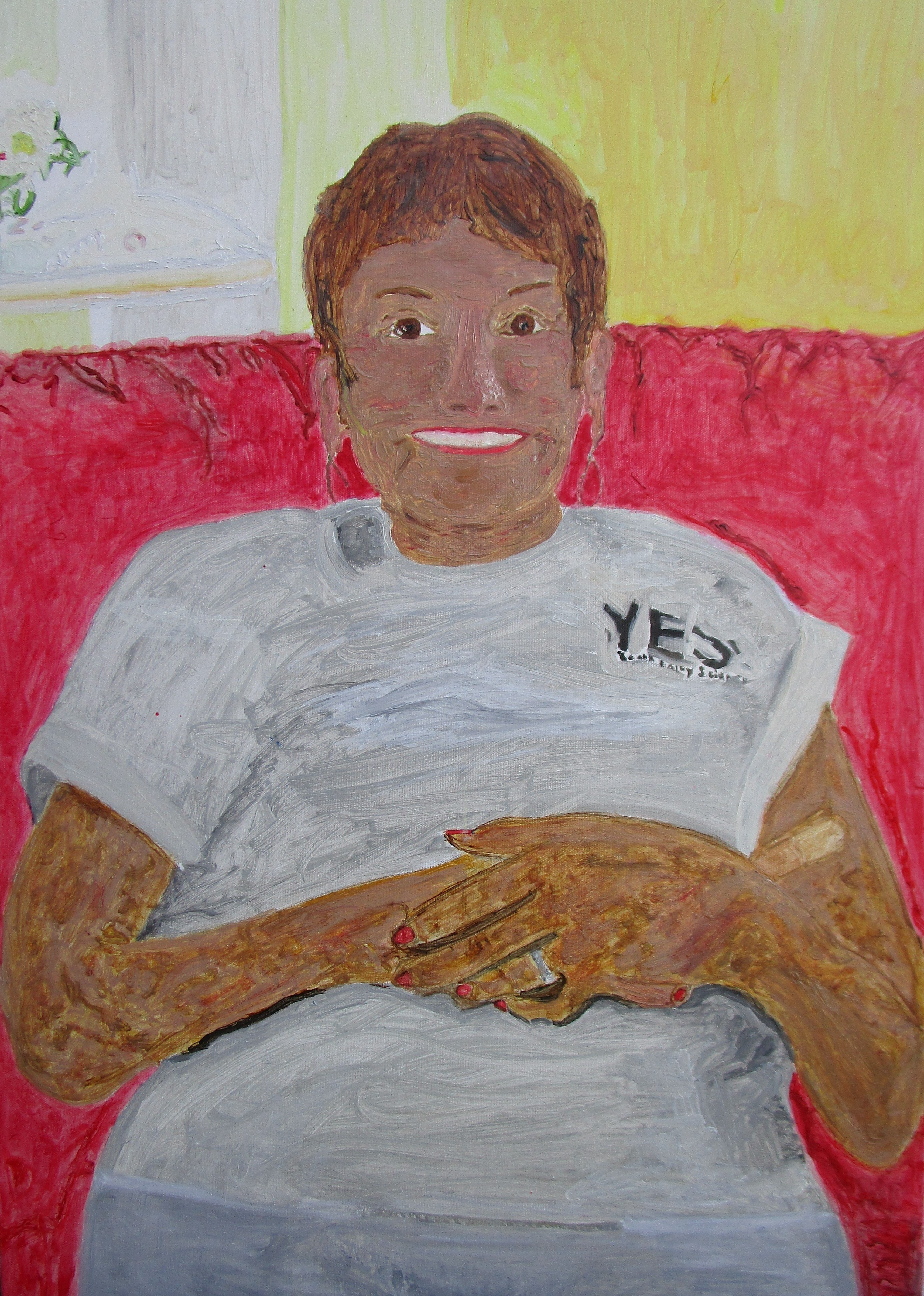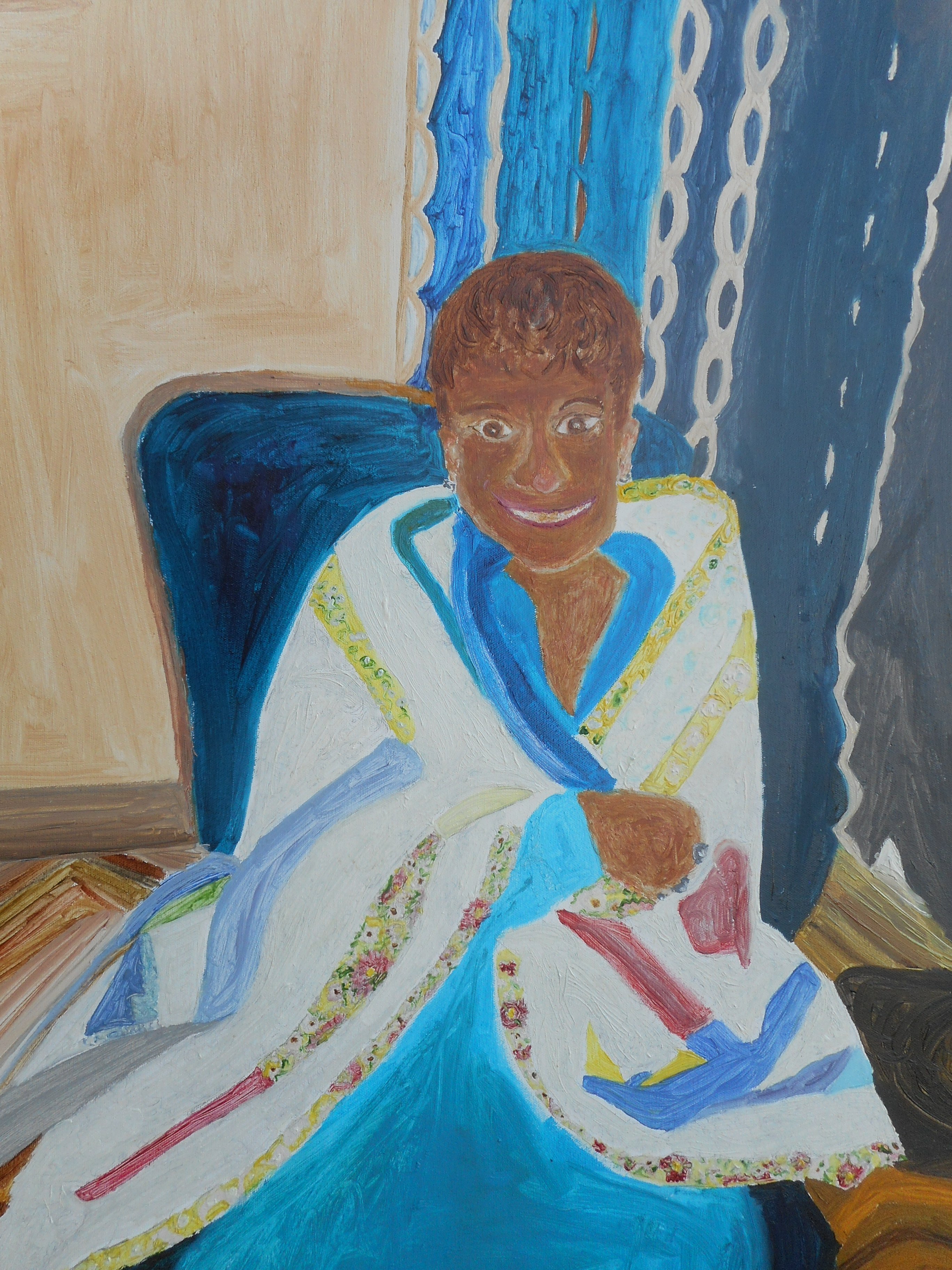Abstract
Suzanne, an elder of The Osage Nation, has been diagnosed with basal cell carcinoma, squamous cell carcinoma, and melanoma skin cancer. Her daughter, Bobbie, a cancer researcher working for the Youth Enjoy Science Research Education Program, conducted a case study to share Suzanne’s story through written narrative and a series of images that present Suzanne’s reflections on cancer prevention and treatment from a holistic perspective. Seven interview transcripts, as well as photographs, drawings, and paintings of Suzanne, were created and analyzed to explore Suzanne’s lived experience of cancer. In her story of living with cancer, Suzanne shares an elder’s love and wisdom that can inform cancer education and prevention efforts to help address Native American cancer disparities.
Native Americans Do Get Skin Cancer
Nearly 1 of 10 Native Americans (NAs) believe that Native peoples do not develop skin cancer, and nearly 9 of 10 have been sunburned at least once.1 Melanoma skin cancer among NAs is less common than among whites2; however, only 1 of 10 NAs report using sunscreen regularly on their bodies,1 and skin cancer among NAs often goes underdiagnosed until more advanced stages.2 NAs’ perceptions of their low risk of skin cancer, coupled with limited access to health care services, could contribute to the finding that, historically, NAs have made significantly fewer office visits to a dermatologist than whites.3 Scholars and practitioners recommend increasing public awareness and public health education and improving screening and early detection to prevent cancer.4 In an effort to raise the NA index of suspicion and increase efforts to prevent skin cancer among NAs, we share Suzanne’s story through written narrative and portraits as a case study exploring one NA woman’s lived experience of skin cancer.
Suzanne, an elder of The Osage Nation who resides in Tulsa, Oklahoma, has spent the majority of her life outdoors, in the water and under the sun. Suzanne grew up in the Great Plains near the Osage ancestral lands, surrounded by rivers and lakes. She loved to swim and embodied the Osage sacred name “children of the middle waters.” Suzanne’s daughter, Bobbie McWilliams, citizen of The Osage Nation, an undergraduate fine arts major/Native American studies minor and a Youth Enjoy Science (YES!) Research Education Program cancer research intern at the University of Nebraska Medical Center, and Regina Idoate, citizen of the Cherokee Nation of Oklahoma, conducted a case study to share Suzanne’s story through written narrative and a series of images that can promote awareness of and reflection on cancer prevention and treatment from a holistic perspective. This article shares Suzanne’s story, both verbally and visually, as analyzed through arts-based narrative inquiry. Bobbie conducted and transcribed 7 interviews and created several drawings and 5 portrait paintings of Suzanne that were qualitatively analyzed by the authors of this manuscript to share her story as an aesthetic whole.
Suzanne’s Story
Suzanne tells stories of being exposed to the sun even as a baby: “My mother had me in a buggy and … my legs would turn black, just black.” Growing up, Suzanne had a special relationship with the sun. She loved to swim and loved to be outdoors. Bobbie illustrated Suzanne’s description of her childhood in a portrait that reflects her youthful unprotected exposure to the sun (See Figure 1). She swam outdoors so much as a child that she recalls wearing out the bottom of her bathing suit. When Suzanne was a teenager, she and her friends, wanting to be tan, “used baby oil and iodine and … would actually almost fry in the sun.” In college, too, Suzanne regularly sunbathed and spent hours in the pool performing synchronized swimming routines with her sisters. Suzanne says that, throughout her youth, she was never told to wear sunscreen and doesn’t recall being aware that sunscreen lotion even existed. She’s convinced that her family, teachers, and health care professionals didn’t even know about skin cancer.
Figure 1. Curious Sue, by Bobbie McWilliams, 2018

© 2020 B. McWilliams.
Media
Acrylic on canvas.
As a child, Suzanne does not remember ever thinking about protecting her skin from sun exposure. Although her mother’s understanding of life and nature recognized dangers of the sun—and if her mother “happened to be in the sun, she’d have a great big hat on her head to cover up”—Suzanne never thought about the possibility of developing skin cancer. She spent most of her youth at the pool, training to be in the Olympics for diving, working as a lifeguard, and teaching swimming and lifesaving to both elders in her community and children at orphanages. She remembers “just like it was yesterday” teaching swim strokes under the sun on a grassy hill beside the pool.
After marrying and growing a family, Suzanne taught all 9 of her children how to swim and took them to the pool all summer long, every year. She describes swimming with her kids and living life at the pool as “a lot of fun!” Suzanne continued lifeguarding well into her 50s and is still swimming today.
Suzanne never thought about the possibility of developing skin cancer.
In the summer of 1988, at age 56, Suzanne was diagnosed with skin cancer. She states, “It’s just something that I got.” She explains, “I went to a skin doctor because I had different things on my arms and legs.” The doctor, however, found something on her back. Suzanne was shocked and “didn’t know what it was.” She vividly recounts the doctor saying, “you have skin cancer.” She “was just flabbergasted, and … just couldn’t believe it!” Suzanne’s first thought was that she would no longer be able to swim or be in the sun. She is happy to say, however, that she still visits the pool regularly and enjoys the sun in small amounts, wearing clothes, hats, and sunscreen to reduce her risk of skin cancer. She also visits the dermatologist regularly for screening.
Suzanne has had as many as 33 precancerous spots on her face and body treated and, according to her, she has been diagnosed with “every kind of skin cancer possible.” She calculates that, for her, “the cancer usually grows an inch apart from one another.” She describes a precancerous lesion as “a skin lesion that’s formed before cancer.” She explains that screening is important because “the skin doctors can tell that it’s a precancer … and they treat them so they won’t turn into cancer.” She has been diagnosed with basal cell carcinoma, which she describes as “more of a topical skin cancer,” squamous cell carcinoma, which she says “forms kind of a crust on your body,” and melanoma, which she refers to as “the bad one.” In Suzanne’s words, “basal cell skin cancer is … on top of your skin and it normally bleeds, and it is usually scraped off or burned off, preferably, rather than having it cut out.” She describes how basal cell carcinoma “won’t stop bleeding until you have something done about it.” She says that squamous cell carcinoma “forms a very crusty top, and it’s a bit painful, if you touch it … and they have to get that out because that could spread, and get bigger and bigger, the crust part on top.” She warns, “what’s ever on top of your skin is also underneath, so you have to be careful with that and be sure that you have it taken out.”
The type of skin cancer that Suzanne fears the most is the one she calls “the bad one,” melanoma. She learned from her dermatologist that melanoma “could spread through your entire body.” Suzanne describes noticing the melanoma on her body as "one very black spot." She says, "it was extremely shiny, and very small, like a pencil head, and it just didn’t look right.” The Skin Cancer Foundation urges people to examine their skin from head to toe on a monthly basis.5 Suzanne saved her own life by doing just that, noticing the melanoma on her body and going to the doctor to ask, “What is this?” Suzanne says, “I thought it might travel and I wouldn’t be alive today. I had to go to the hospital and they had to cut it out, I guess they did a good job because there’s only a dent in my arm from where they cut—that’s all, it’s fine.”
When discussing her experience with melanoma, she says, “I was glad that it hadn’t spread any further than my arm, very glad…. I’ve been very fortunate praying, and I have been very fortunate with cancer that it hasn’t gone any further.” Her joy, contentment, and gratitude are evident in her smile, her bare and relaxed arms, and the YES! t-shirt that she proudly wears in Smiling Sue (See Figure 2). At age 84, Suzanne lost her beloved husband, John, in 2015, but she still enjoys precious time with her 9 wonderful children and loves to make time for friends: “We try not to talk about illness when we’re together, we just want to have a good time.” She asserts, “I’m very happy that I’m able to do the things I like to do…. I feel like I survived very well the cancer that I’ve had, and I’m still getting it, and hopefully it won’t be the bad one.”
Figure 2. Smiling Sue, by Bobbie McWilliams, 2019

© 2020 B. McWilliams.
Media
Oil on canvas.
If you talk to Suzanne, she will tell you, “I still love the sun!” Observing the portraits, a viewer might notice not only Suzanne’s love for the sun but also her gratitude to be alive to share her story. Reflecting on one of her own portraits, Suzanne states, “It shows how my skin really is … and I don’t think that my skin looks very good, and the truth is that it shows in the portrait what it really is!” (See Figure 2). She admits, “I know that I have a lot of skin cancer, my whole body is full of skin cancer.” Suzanne has new cancers and spots forming all the time. Every time she goes to the dermatologist, more cancers are removed. Suzanne affirms that “to survive all this, I’ve been very fortunate, extremely fortunate…. There are many people who have had cancer way worse.” In fact, she adds, “My sister had melanoma in her leg and it just wouldn’t heal, they tried and tried, and then it got infected and then it got worse, it was a contributing factor to her death at age 86 years old.” Ultimately, she says, “I hope others don’t get it” and “if it [Suzanne’s portraits and story] could help just one child or one person to be careful in the sun, it would be all worth it!” Suzanne is very proud of the cancer research and prevention work that her daughter, Bobbie, is doing with the YES! program, noting, “I feel very good about sharing my story, very good about it.” Suzanne wants to tell the youth “not to go to tanning beds and to be very careful.” She emphasizes, “I would like them to know that they should go out and have a good time, stay healthy, and be happy, but wear some sunscreen or a shirt or something over their skin so that they won’t get the skin cancer that I have had.”
Learning From Suzanne’s Story
Suzanne’s story can help promote cancer awareness, prevention, and control within Bobbie’s local urban NA community in the Northern Plains region of the Indian Health Service, as cancer is a leading cause of premature death among NAs, and NAs experience severe health disparities specific to cancer.6 Bobbie presented Suzanne’s story as a case study in a research poster at the 2019 Nebraska Science Festival in Omaha, Nebraska7; at the 2018 American Indian Health Research Conference in Grand Forks, North Dakota8; and at both the 2018 and 2019 Cancer Biology and You (CBY) workshop for NA students in South Sioux City, Nebraska.9,10,11 Participants in the 2019 CBY workshop reported that viewing and discussing the portraits of Suzanne was their favorite activity at the event. In this activity, the authors asked students entry-point questions to encourage them to observe and reflect on the portraits of Suzanne.12 This approach can open up a dialogue around cancer, a topic often considered taboo in NA populations.13 Bobbie stresses that anyone can get skin cancer, even a citizen from The Osage Nation with a dark completion. Suzanne reaffirms this fact, noting, “I do look very Indian, and I don’t think there’s a whole lot of us that really do have skin cancer, but I certainly do.”
CBY participants said that, in viewing Suzanne’s portraits, they hear Suzanne saying, “protect yourself,” and they see “joy” and an encouraging message to enjoy life and “live long” in her image. Wrapped in a quilt, Suzanne embodies a powerful message, reminding us all to cover up and protect our skin (see Figure 3).
Figure 3. Suzanne’s Wisdom, by Bobbie McWilliams, 2019

© 2020 B. McWilliams.
Media
Oil on canvas.
References
- Maarouf M, Zullo SW, DeCapite T, Shi VY. Skin cancer epidemiology and sun protection behaviors among Native Americans. J Drugs Dermatol. 2019;18(5):420-423.
- Kryatova MS, Okoye GA. Dermatology in the North American Indian/Alaska Native population. Int J Dermatol. 2016;55(2):125-134.
- Fleischer AB Jr, Feldman SR, Bradham DD. Office-based physician services provided by dermatologists in the United States in 1990. J Invest Dermatol. 1994;102(1):93-97.
- Warne D, Kaur J, Perdue D. American Indian/Alaska Native cancer policy: systemic approaches to reducing cancer disparities. J Cancer Educ. 2012;27(1)(suppl):S18-S23.
-
Skin Cancer Foundation. Self-exams save lives: early detection starts with you. https://www.skincancer.org/early-detection/self-exams/. Accessed November 26, 2019.
- White MC, Espey DK, Swan J, Wiggins CL, Eheman C, Kaur JS. Disparities in cancer mortality and incidence among American Indians and Alaska Natives in the United States. Am J Public Health. 2014;104(suppl 3):S377-S387.
-
McWilliams B, Robbins R. Suzanne’s story. Poster presented at: Nebraska Science Festival; April 27, 2019; Omaha, NE. https://sciencefestivals.org/festival/nebraska-science-festival/. Accessed February 18, 2020.
-
McWilliams B, Robbins R. Suzanne’s story. Poster presented at: 16th Annual American Indian Health Research Conference; October 20, 2018; Grand Forks, ND. https://ruralhealth.und.edu/assets/1917-8100/aihrc-agenda.pdf. Accessed February 18, 2020.
-
University of Nebraska Medical Center. Interprofessional Education at UNMC: 2018 Annual Report. https://www.unmc.edu/academicaffairs/educational/ipe/UNMC_IPE_AnnualReport.pdf. Accessed February 25, 2020.
-
Herek TA, Branick C, Pawloski RW, et al. Cancer biology and you: an interactive learning event for Native American high school students to increase their understanding of cancer causes, prevention, and treatment, and to foster an interest in cancer-related careers. J STEM Outreach. 2019;2:1-14.
-
McWilliams B, Idoate R. Exploring skin cancer through portraiture inquiry. Poster presented at: Cancer Biology and You Day; October 29, 2019; South Sioux City, NE.
-
Simon D. The Entry Point QUESTs: constructing understanding in the visual arts. In: Hetland L, Veenema S, eds. The Project Zero Classroom: Views on Understanding. Boston, MA: Harvard Graduate School of Education; 1999.
-
Idoate R, Gilbert M, King KM, et al. Urban American Indian community health beliefs associated with addressing cancer in the Northern Plains region [published online ahead of print March 11, 2020]. J Cancer Educ.




